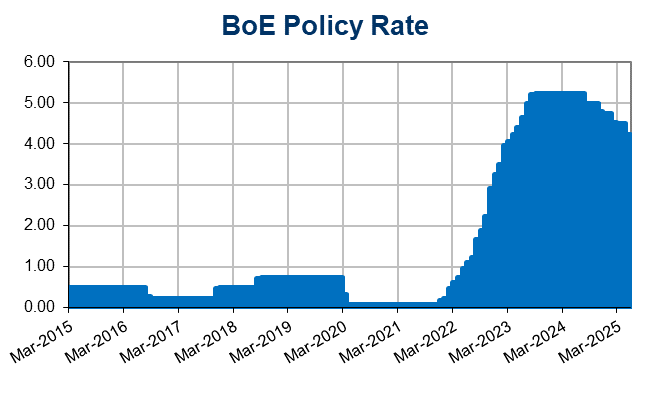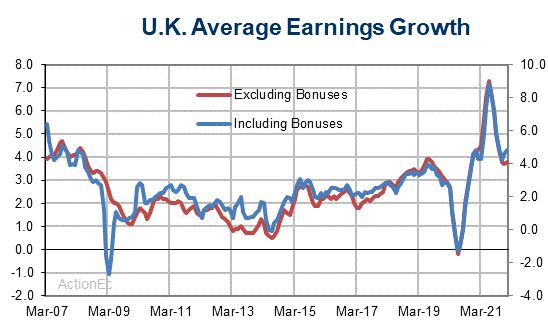The BoE is facing a very difficult situation, and while the recession may not be quite as bad as feared initially, it will likely be pretty protracted. There are also signs that medium term growth potential is lower than previously thought. Inflation is coming down faster than initially expected, at least in the headline numbers. While it is a close call, we see a good chance for a downgrade in the BoE’s tightening cycle, and a move to 25 basis point steps on Thursday.

Unlike the ECB, the BoE delivered a rather cautious hike in December, and two MPC members opted to keep rates on hold and take a pause even against the background of extremely high inflation. At the time this prompted many to downgrade their prediction for the February decision, and to pencil in a quarter point hike. Some better than anticipated growth numbers subsequently prompted the majority to revert to a half point hike, and markets are essentially pricing in an 80% chance of a half point move, with consensus expectations predicting another 25 bp for March and a peak rate of 4.25%.
Markets are also penciling in a relatively quick reversal of tightening moves, with the BoE expected to start reversing previous hikes late this year or early in 2024. Given that the BoE is facing an extremely difficult and uncertain situation at the moment, it is likely that central bank will take a more measured approach and switch to 25 basis point steps, especially as rates are already in restrictive territory. That means the BoE has already reached the point where it has to very carefully weigh the risk of “doing too little” against that of “doing too much”.
Headline inflation ended 2022 at an extremely high level, but price increases have decelerated more than initially anticipated. Core inflation stagnated rather than rising further. Last week’s release of producer price inflation for November and December, which had been delayed by some fundamental revisions to the calculations, also suggested that price pressures are easing fast. Input price inflation declined for a sixth consecutive month in December, and output price inflation has dropped every month since August. At 14.7% y/y, output PPI remains very high, and it is evident that there are still pass-through effects in the pipeline.

Nevertheless, wholesale gas and electricity prices have roughly halved relative to the assumption used in the BoE’s November monetary policy report, and inflation projections this week are likely to look tamer. Officials have detected some signs that the labor market is slowing, which should keep a lid on medium term wage growth. Growth projections may be revised up, but largely due to signs that Q4 of 2022 was less weak than previously assumed. Preliminary PMI reports for January, however, looked extremely weak and signaled contraction in activity at the start of the year.
More importantly, estimates for longer term growth potential are being revised down. A report in the Times (paywalled) suggested that the Office for Budget Responsibility (OBR) already warned chancellor Jeremy Hunt that it overestimated the prospects for medium-term growth in the economy.
The BoE has also flagged the problem of a shrinking workforce, and BoE’s Bailey suggested that he expects a shallow, but protracted recession. So the new set of economic forecasts may bring better than expected estimates for 2023, but are likely to look gloomy for the rest of the forecast horizon. At the same time, a shrinking labor force not just curtails growth, but also increases the risk of pay pressures. Surveys indicate though that labor demand is slowing as companies remain concerned about the outlook.
Fighting inflation clearly is in the interest of the government, and we don’t suggest that the BoE is ready to pause just yet. Still, with longer term growth potential eroding, inflation coming down faster than anticipated, and little chance of expansionary fiscal policies, we see a good chance of a slowdown in the pace. Against that background, the fact that the Fed is also likely to switch to 25 bp steps makes this even more likely, as a downshift in the UK won’t change policy differentials.
Cable may still be hit initially if markets are wrong-footed, but the fact that the Fed is also turning more cautious should help Sterling to recover. Currently Cable is at a crucial technical level, as it has recovered 50% of 2021 losses.
By holding gains in January above the 50-week EMA and the 50% Fib. level, technically it presents a bullish momentum. The MACD oscillator has turned positive while the RSI is flattening at the 60 level, suggesting the near term momentum is neutral until BoE and Fed are out.
Further gains should see the 1.2440 level acting as a major resistance ahead of the 1.2800 resistance level, which is the 61.8% Fib. level and the upper boundary of weekly Bollinger Bands. A break of the former would reinforce the bullish structure in the medium term and open the way towards 1.2800 and even higher as it might confirm a potential inverse head and shoulders formation (June 2022 – up to date).
In the event of a downside reversal, initially the bottom of the 2-week ascending triangle and the 50% Fib. level at 1.2270 could act as immediate support level before being able to re-challenge the 1.2450. The 1.2100 though which is the confluence of 50- and 200-day EMA is the most significant support level to be watched in the medium term as it could change the overall neutral to positive outlook for Cable.
Click here to access our Economic Calendar
Andria Pichidi
Market Analyst
Disclaimer: This material is provided as a general marketing communication for information purposes only and does not constitute an independent investment research. Nothing in this communication contains, or should be considered as containing, an investment advice or an investment recommendation or a solicitation for the purpose of buying or selling of any financial instrument. All information provided is gathered from reputable sources and any information containing an indication of past performance is not a guarantee or reliable indicator of future performance. Users acknowledge that any investment in Leveraged Products is characterized by a certain degree of uncertainty and that any investment of this nature involves a high level of risk for which the users are solely responsible and liable. We assume no liability for any loss arising from any investment made based on the information provided in this communication. This communication must not be reproduced or further distributed without our prior written permission.























